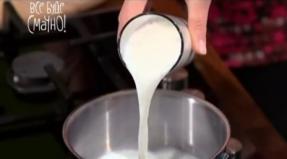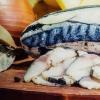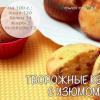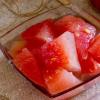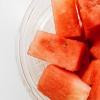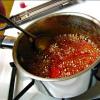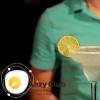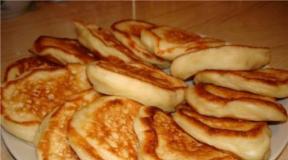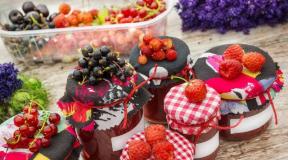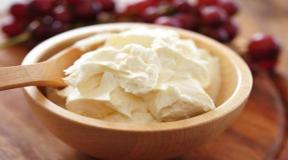Chinese tea bags. Elite tea bags
The consumption of tea bags worldwide covers an average of 70% of total purchases. This means that tea bags are the most popular and in demand. It is surprising that in England, a country for which tea has become not just a drink, but a way of life, this figure rises to 90%.
What should be an elite bag
There are tens and hundreds of varieties of tea and forms in which it can be purchased. From expensive pressed Puerh to rare Chinese green tea, consisting entirely of pubescent young tips. Is there an elite tea bag and can it be recognized by the information on the package? Yes, it exists, but this product is rare and is produced by tea companies of Great Britain, India, China, Italy, little-known in Russia.
These companies buy lots of elite varieties of green and black leaf tea and are engaged in its processing and packaging.
What does elite mean? Elite tea means not so much a rare variety of tea as the quality of the leaf itself. This is a young succulent leaf harvested in the first spring harvest with the top bud. The most valuable are the first two leaves on the branch and the unblown bud covered with white fluff.
Well-known brands never blend elite varieties of tea, so the packaging always contains the same name of the variety and the region where it was brought from. The shelf life of any packaged product is 1 year. Only Pu-erh has an unlimited shelf life, but unfortunately it does not exist in bags.
Silk bag - appropriate packaging for an elite product
The Whole Truth About Tea Bags
Judging by the Russian tea market, the situation here is almost critical. Finding a really high-quality, expensive and correct packaged product is very difficult, or rather almost impossible. Domestic manufacturers have not yet been able to confirm the information indicated on the packaging that the individual bag really contains a high-quality shredded sheet product.
According to the research results of the most popular brands of Russian tea, the cherished leaves were not found in any of the samples. As a rule, either sifting or so-called dust was found in the bags. In the first case, we are talking about the smallest fragments of tea leaves that remained after sifting the tea. Twigs crushed to a fine fraction and dust or debris as the end product of tea production were also found.

Such dust is usually packed in a bag.
Even tea in pyramids, which by definition should be higher than ordinary tea bags, could not confirm the status of an elite product. The best thing the experts have found is shredded old tea leaves, most likely obtained after sanitary pruning of the bush. Why it happens?
- According to the prevailing stereotypes, tea bags, Chinese or Indian, cannot be of high quality, and therefore expensive. That is why the domestic manufacturer does not pack an elite variety of tea leaves in a bag or pyramid, since no one will pay more for such a product than for a loose product that is at least visible to the eye.
- The tea bag should brew quickly and give a rich color to the infusion. This is not easy to achieve using a small sheet. It is much easier and cheaper to put small granules or dust in a bag, add dye and flavor and get a product in demand on the market.
It cannot be said that all 100% of tea bags are low-grade products. There is really the right elite tea that meets all the requirements in its class, but it is difficult to acquire it due to a narrow circle of consumers, a small supply and a high price. And the cost of such tea is really high, because its production is associated with impressive financial costs. This is a special production technology, according to which the tea leaf is specially processed and later crushed so that the consumer can quickly brew it and enjoy the taste and aroma.
In addition, the elite variety of tea itself is expensive, especially the Chinese high-mountain tea, collected in the spring during the period of active sap flow in the bush. Packaging requires no less cost, because often such a product is packed in silk bags, which are later placed in a foil bag and a common box or jar. It is so difficult and expensive to produce an elite tea bag product abroad, for example, in the UK and Germany.

Such a pyramid inspires confidence
Elite teas
A tea bag may contain green, black, red leaves, herbs, flower petals, fruit pieces, and other additives and flavors. Below is a list of the most elite Chinese green teas, expensive and quite rare.
According to experts, these products can rejuvenate the body, strengthen health, prevent the development of tumors and simply improve the quality of life due to the tonic and general strengthening effect.
- Bilochun - green tea from plantations near Taihu Lake. Its distinctive feature is a delicate fruity aroma and an abundance of white buds in the infusion. Rich in amino acids and antioxidants.
- Huangshan Maofeng is a drink with a slight sweetish aftertaste. It has an unusual leaf shape, which is curled in such a way that its upper tip is in the middle. Green.
- Da Hong Pao - green, combines several varieties within a variety. Can produce fruity aromas, spices, chocolate and even caramel flavors. The drink has a positive effect on blood, the condition of tooth enamel, and prolongs youth.
- Xihu Longjing - has an emerald leaf color, floral aroma and delicate taste. Helps eliminate toxins, is cancer prevention.
- Qi Men Hong Cha is a red tea with a wine aroma and fruity notes on the palate. Gives honey and pine aftertaste. Collected 2 times a year.
India and Kenya also have many decent teas, including red, green and white, which are equally in demand in the market. But in these countries, the history of tea is not so rich in facts, achievements, and the attitude to this product is not as reverent as in China. That is why the Celestial Empire holds the leadership in the market of both loose and packaged tea.
It is impossible to study Chinese tea in a few days. A one-time successful or unsuccessful brewing is not a reason to draw conclusions about the properties and tastes of the drink. The culture of tea drinking does not tolerate haste. The same leaf in different dishes and water will open differently, demonstrate new aftertastes and aromas.
The original product cannot be associated with the usual bags, mugs and boiling water. There are no artificial flavors or colors in real Chinese tea. Only natural pleasant taste, aroma and color, as well as many cooking variations.
It is difficult to find original quality tea. Sellers often buy cheap raw materials from suppliers in order to pack them in a beautiful wrapper and send them to the average consumer. The choice of a store should be approached with all responsibility.
On a note! To find out the taste of real Chinese tea, you need to look at the list of shops specializing in these products. You cannot find original goods in the supermarket!
Origin and types
The homeland of Indian, Kenyan and other tea leaves is China. It was here that a bush was first discovered, giving the world a wonderful drink. From the southwestern territories of China, tea cultures spread to neighboring countries.
Today, the tea plantations of the Celestial Empire grow up to 1,000 varieties, divided into 7 main types. Which one should you try first? Even sophisticated tea experts cannot answer this question, tk. all people have different tastes and preferences.
The majority of the world's population knows what black or green tea is. But only a few were lucky enough to have a tasting of oolong or original pu-erh.
This means that for a successful acquaintance with Chinese tea, it will be right to buy different types - a set of samples from time-tested varieties of tea, known on the world market.
The price of quality probes cannot be low. After all, high-grade young leaves or miniature buds are used for raw materials. This is an important point for choosing the right product.
Red tea
The most popular product on the world market. Often buying red tea in a store, people are convinced that they are buying black long tea. In fact, the quality of second-rate products can confuse even an experienced tea expert, let alone an ordinary consumer. The reason is clear - raw materials are packed "from one barrel", different varieties are mixed, dressed in different packages, accompanied by a powerful advertising campaign.
In fact, there are few natural Chinese red teas. The leaves are processed by hand and using machines. Such a product is expensive!
Real red teas, for example, Qimen Hongcha, Dian Hong, Xiaozhong, Jin Jun Mei (Golden or Silver eyebrows) and others, are produced exclusively from pubescent tea buds, as well as young tops with two or three leaves open.
Then, for 2-3 hours, the harvested crop is spread on the street "for rest", then it is driven under hot air in long trays and sent to rollers. Crumpled leaves oxidize, turn brown, acquire a special aroma.
After the final drying of raw materials in a special cabinet, fermentation stops. You can start sorting and packing the sheet for sales.
Xiaozhong is additionally smoked on pine wood, as a result of which the raw material acquires a special smoky aroma. Qimen Hongcha has a fruity-wine flavor with light pine notes. Dian Hong is characterized by the sweet scent of rose, Chinese plum (lychee) and longan fruit.
On a note! Original tea from China has a strong and persistent odor, but not pungent! Beware of flavored counterfeits!
Black tea
Chinese black tea is nothing more than post-fermented shu pu-erh, the most famous beverage native to the renowned province of Yunnan.
The production of this type of Chinese tea in placers or briquettes is a long and complicated process. The raw materials collected from plantations are aired, dried, rolled, bitter juices are squeezed out and heated in giant bunkers. The semi-finished product is fermented for tens of hours under special temperature conditions. At the exit, the tea turns out to be soft, shiny, of the usual black color.
Experts know that proper oxidation of the leaf changes its aroma, reduces astringency, and removes bitterness.
The finished raw material is dried and pressed. It is noteworthy that in loose form, the product is practically not released. Tablets, cylinders, briquettes and tiles are the familiar form of Chinese black tea that hits store shelves. The strong-tart taste of the drink with the smell of black soil and dried fruits will not be appreciated by everyone. Buyers mistakenly think that the pressed bricks are inferior Chinese teas. Nevertheless, this option has its own buyer. After all, the tea leaves have proven themselves well in the hikes. Tea does not lose its taste for a long time.
Often the buyer is interested in the name given to the Chinese tea in briquettes and why it is considered the lowest grade. It's simple. In everyday life, pressed tea is called "brick", which reflects the shape of the product. And the infusion received a low quality due to the presence of broken branches, crumbs and damaged leaves among the leaves.
Although the Chinese themselves are not embarrassed by the "dubious impurities". Brick black tea is widely distributed throughout China and beyond.
Green tea
Lightly fermented leaf retains flavor better. The manufacturer's task is not to violate the integrity of the sheet. It is this type of Chinese tea that has all the versatility of tastes and smells.
Depending on the variety, you can find floral, fruity, herbal aromas and a variety of richest aftertastes here.
Famous drinks:
- Xihu Longjing
- Dongting Bilochun
- Huangshan Maofeng
- Luan Guapian
Xihu Longjing is originally from Zhejiang Province. In the production of this green Chinese tea, only the top two leaves are used, which are collected and processed by hand. The high-grade blend resembles short pine needles (up to 2 cm long). When brewed, it forms a yellow-green infusion with a slight aroma and a sweetish aftertaste. It's expensive. To the ordinary consumer, the manufactory offers several varieties of tea, for example, Da Fo Longjing, Shi Feng Longjing and others.
Dongting Bilochun is distinguished by green spirals with slight pubescence. When brewing, the leaf is poured into hot water (about 80 degrees). Tea leaves sink to the bottom of the container and open up. Emerald infusion has natural sweetness and special freshness.
Huangshan Maofeng is a needle green Chinese tea produced by low fermentation. A high-quality infusion is characterized by the color of a yellow apricot, light greens are allowed. The taste of the drink is refreshing, with floral notes.
Luan Guapian is known worldwide as Luan Pumpkin Seeds. Indeed, the size and shape of fresh tea leaves vaguely resembles a pumpkin seed. Weakly fermented tea leaves are characterized by light longitudinal curling of leaves without buds or branches and a dark green color. The finished infusion is dominated by yellow color and aromas of wildflowers.
Yellow tea
This type of tea from China has an even weaker fermentation than green tea. Made from high quality raw materials. It is considered an imperial drink.
Varieties of yellow tea:
- from the kidneys: Yin Zhen (Silver needles); Meng Ding Huang Ya (Yellow Buds)
- from leaves: Ho Shan Huang Ya (small tea leaves from Ho Shan mountain); Beigang Maojian (Hairy buds from Beigang).
When collecting raw materials for yellow tea, a number of strict rules are followed. First, the leaf is not torn in the rain. Secondly, the kidneys must be missed:
- with dew
- with a purple tint
- hollow
- sluggish
- revealed
- damaged
- other than the standard size.
The process of making yellow tea takes about 3 days. The final taste of the brew is directly affected by languishing in a fabric (parchment) bag. Factories are very keen on monitoring indoor temperatures and leaf oxidation rates. The output is dark olive tea leaves with silvery down.
The taste of the drink is original - with smoked notes. The color is transparent, close to a light amber color.
Loose yellow tea is very healthy. It soothes headaches, relieves spasms, increases mental activity and generally tones the body.
Proper brewing does not tolerate the use of steep boiling water. It will destroy the aroma of the infusion and show natural bitterness. Tea leaves are poured with water from 70 to 85 degrees.
White tea
White tea got its name from the appearance of the kidney, which is densely covered with white villi. The main philosophy behind the preparation of this type of Chinese tea is to preserve the primary characteristics of the tea leaf by eliminating mechanical processing.
Chinese emperors believed that the drink was able to clear the mind and fight the causes of 100 diseases.
Varieties of white tea:
- Baihao Yinzhen
- May show
- Gong mei
- Da Bai Hao
- other.
The aroma of dry gray-green tea leaves is unique, easily distinguishable from other categories. The color of the blend can be uneven, with brownish or silvery blotches. This is the norm. The color of the infusion is light peach-amber.
The taste of the drink refreshes, gives the richest range of aromas: honey, peaches, melons.
There is often a combination of white tea with jasmine flowers, chrysanthemum and other additives that drown out the natural taste of the drink. Well, it all depends on the preferences of the buyer.
On a note! An unscrupulous seller is ready to pass off green tea as white. An inexperienced tester cannot expose a fake. Taste memory comes with experience. It needs to be developed!
Oolong
Unlike black or green tea, this tea from China, prepared using a special technology, is not drunk by every European.
Blends are made from fleshy adult leaves of tree-like bushes located on highland plantations. There are no kidneys with villi here.
The edges of the sheet and part of the surface are oxidized, leaving the internal structure unchanged. This step allows oolong to harmoniously combine the bright aroma of Chinese green tea and the richness of the taste of red tea.
Varieties:
- Da Hong Pao
- Bai Ji Guan
- Tie Luo Han
- Alishan
- Tie Guan Yin
- Dong ding
- Jin xuan
- other.
Any oolong tea contains a lot of tannins, caffeine, essential oils, a number of vitamins: C, D, K, E, B (1-12). It is very beneficial for the body.
Aromatization of blends with petals of jasmine, rose, fragrant olive, and other additives is allowed. As a rule, the manufacturer indicates the presence or absence of flavorings on the packaging of Chinese tea.
Thus, Jin Xuan is a milk oolong with a characteristic creamy smell. The natural aroma of the drink is so light that factories are trying to enhance it by using foreign components. Important! A note about this must be indicated on the package.
In general, each oolong is distinguished by its unique aroma and flavor notes: spices, chocolate, fruits, wildflowers, nuts, etc.
On a note! Real Chinese Oolong tea is always whole leaf, without crumbs, scrap and dust. When exposed to boiling water, dark edges and veins are clearly visible on the expanded leaves.
Chinese tea in dietetics
For those who are on a diet, it is important to find tea that will not so much speed up the metabolism in the body (this task must be solved in a complex manner), but will help to replenish the amount of nutrients and vitamins. Agree, vitamin deficiency, a lack of magnesium, potassium or other elements can ruin all the impressions of the weight loss procedure.
From this point of view, you should pay attention to the following Chinese teas for weight loss: any kind of pu-erh, oolong, green or yellow tea.
So, in narrow circles, Pu-erh is called the elixir of youth. Drink a warm infusion without sugar immediately after eating. Pu-erh, cooked in skim milk, can even replace breakfast or lunch.
It is an excellent antidepressant that can help you cope with stress and psychological stress during a diet. Pu-erh helps to lose weight due to its diuretic action. It is recommended to drink this Chinese tea no more than 1 liter per day.
Oolong tea contains active substances that accelerate metabolic processes by almost half. It is a wonderful antioxidant that prevents premature skin aging.
Mildly fermented green and yellow Chinese tea leaves are rich in vitamins and minerals. While on a diet, it is very important to maintain the health of your hair, nails, skin and the body as a whole. Real Chinese teas are really the best in this regard.
Free radicals are a by-product of the body's metabolism. Antioxidants help protect the body from free radical damage and slow down the aging process. Catechins are natural antioxidants found in green tea. It is the presence of catechins that gives tea the ability to fight free radicals (antioxidant activity).
Delicious and healthy
Green tea gains invigorating properties thanks to the alkaloids it contains: caffeine and theophylline. In order to get an idea of the tonic properties of each sample, the caffeine content was determined, and most of all it was found in the tea. Maitre de the, and least of all - in samples Greenfield and "Almanac".
Among the samples tested, tea showed the highest antioxidant activity immediately after brewing. Maitre de the, and the smallest - "Princess Java"... And after 20-30 minutes after brewing, the antioxidant activity increased in all samples.
One of the catechins, tannin, is responsible for the characteristic tart taste of tea. Its mass fraction is highest in Maitre de the, lowest of all - at "Almanac".
Tea bags are a salvation for a modern person who is constantly in a hurry. The commute to work, to the gym, to a business meeting or other equally important business takes up a lot of our time, and quickly brewed aromatic black or green tea is what you need for a quick snack.
There is a constant debate about the quality of tea bags.
What tea bag proponents say
- Don't skimp. The tea bags presented on the market differ in quality and, most often, this is judged by the price category of the product. Therefore, if you buy a rather expensive tea bag, then most likely you will get a pretty decent drink in your cup at the exit.
- Diversity. There is a huge variety of types and varieties of such teas, which allows you to choose the most suitable product, as they say “by itself”.
- Convenience. The undoubted advantage is ease of use. For a few minutes, immerse the tea bag in a cup of boiling water and the aromatic drink is ready to drink.
What the opponents of tea bags say
- Real Chinese tea bags are extremely rare. Moreover, even if you are lucky to find one, there can be no comparison with classic custard teas: neither in taste, nor in quality. Since the same tea leaves fall into the bag, but due to their crushing, the proportion of impurities and dust is often quite large.
- You cannot get any pleasure from tea bags! It is impossible to fully taste the full aroma of high-quality tea in 5-10 minutes!
- The price of real Chinese tea cannot be as low as we often see on the teabag shop labels. And if you are lucky enough to find a really high-quality product, then get ready to pay decent money for it.
- A person cannot be called a connoisseur and lover of tea, using exclusively tea bags. Firstly, because the assortment of such a product does not represent all 7 groups of Chinese teas. Secondly, tea in a bag will never give aroma and taste, like tea poured from a teapot into bowls.
Well, the arguments between opponents and tea bag lovers have been going on for many years. Probably, you can only draw your own conclusion about this product by trying it personally .. Choose, try and share your impressions!
Tea bags appeared on the shelves of Russian stores about ten years ago. The West has been using this form of packaging for over 100 years. But true connoisseurs will never drink Chinese tea brewed from a bag.
How tea bags appeared
In general, Thomas Sullivan (a New York merchant), or rather his customers, is considered the inventor of such packaging for tea leaves. In 1904, an enterprising merchant, who decided to save on packaging, packed tea not in cans, but in silk bags. And his naive customers, having bought the product, decided that it should be brewed without unpacking.
There is also a version according to which American soldiers in World War I tied and brewed tea in a bag (and sometimes in a sock) so as not to catch the tea leaves all over the pot.
The tea bag itself was patented only in 1952, although it appeared on the wide sale already in 1910-1920. The production was put on stream by Thomas Lipton. The fabric was already replaced by a special porous paper. At first, there were attempts to use gauze, but it gave an unpleasant taste, because of this, it was quickly abandoned.
Quick tea
In the modern world, almost every second Russian uses a packaged drink.
- First, it is economical. To brew one serving of tea, use as many infusions as necessary.
- And secondly, the brewing time. In the modern world, time for tea ceremonies, alas, is sometimes not enough.
- Thirdly, there is no need to catch tea leaves in a cup. After brewing, the packaging is removed from the cup and discarded.
To attract buyers, manufacturers began to look for new materials and forms for tea sachets. So in 1930, Adolphe Rambold invented a two-chamber bag with a string holder, which is still the most popular today. Due to the even distribution of the tea in the two chambers of the bag, the water freely acts on the tea leaves, making the drink faster.
Later, they began to make round sachets with threads that allow you to squeeze out the tea leaves. There are also inventions like pyramids made from nylon. Tea leaves in them are comprehensively saturated with moisture.
But if everything is clear with the form, then the content sometimes makes you think. Many people still ask themselves the question, what do manufacturers put in bags? The same tea that is packed in cans and cardboard boxes, but pre-cut. Either crushed large-leaved varieties or small leafy parts without veins and stems, which are obtained by sieving, are used.
However, Chinese tea bags are most often of poor quality; they can be packed in an artisanal way right on the street under a canopy, from the waste of tea leaf processing.
Thanks to such grinding, the infusion during brewing turns out to be more beautiful and aromatic than large-leaved one. This is probably why the myth appeared that dyes and flavors are added to tea bags.
How to check the quality of tea bags
It is quite simple to check this: brew the tea, if the drink is transparent, and not cloudy, then there are no extraneous fillers in it. The quality of the drink can also be determined by the contents of the sachet. Rip one of them and look at the composition, it should not contain granulated tea.
The price of tea is influenced by the type of tea used, as well as the growing time and the time of its collection. Of course, the best varieties are made up of the top leaves of the tea bush harvested at dawn. Elite varieties of Chinese tea are not packaged in bags.
There are teas that consist only of leaves grown in one place at the same time. And there are combined compositions, which are compositions from different fees. But the taste of tea infusion, even from the same batch, may vary, it may depend on the weather, as well as on the time of tea collection.
Unfortunately, Chinese tea bags do not last long. It absorbs moisture and foreign odors faster than leaves, while losing its own aroma. The reason for this is the shredding of the leaf. But it should be noted that the tea leaves packed in an individual sachet made of paper or foil are stored the longest.
The eternally hurrying contemporary appreciates speed and convenience, without delving into the essence. Tea bags are a kind of plastic dish for one use. Sometimes it is convenient, but at home and constantly it is unbearable. For those who want to comprehend the age-old wisdom and drink real Chinese tea, finding harmony of the soul - bags are contraindicated.
JavaScript required or player update required!

